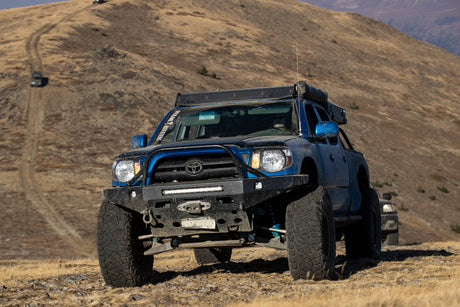LCA Skids
Drop Bracket Lifts & Spacer lifts
Dual battery cages in stock location
Cold air intake
We often get people coming into our shop, or sending in emails asking for a few different products, and I have the same answer for each one: “don’t bother”. The overland scene is very expensive, and there are a lot of products out there that are not necessary, or don’t work very good. I figured I might as well make this video in an effort to save you some money to spend on other things that will actually help you go further.
I’m going to go through a few of these mods that I don’t think are worth buying, and let you know why. I’m fully aware that some of these mods are popular, so if you disagree with me, let me know in the comments below!
Mod #1:
LCA skids.
These are skid plates that bolt to your lower control arms in the front. Typically most of the ones I’ve seen are made of aluminum, but there are steel ones out there as well.
In my opinion, these LCA skids are completely pointless. I’m really not even sure what they are supposed to be protecting? The LCA is a pretty robust chunk of steel already, and doesn’t really need any protection. But as soon as you bolt a skid on there, you are actually losing clearance under the truck. Not only that, but you are increasing unsprung weight which hampers suspension performance.
On many of the LCA skids I’ve had to remove to work on trucks in our shop, when we remove them, a whole bunch of water and mud comes pouring out of the drain holes on the LCA that were blocked by the bolts and skid, meaning that you are actually making it more likely to have rust issues in your LCA when running these skids.
I’ve smashed stock LCA’s on lots of rocks and literally never seen more than a scratch or maybe a small dent. To me, these LCA skids actually do more harm than good to the capability and longevity of your truck.
Mod #2:
Dual battery or larger battery cages in the stock location.
I frequently get asked about installing 2 batteries in the stock battery location, or installing a larger, heavier battery in the stock spot with a battery cage.
I have nothing against dual batteries, or bigger batteries. I don’t even have a problem with battery cages themselves. What I do have a problem with, is how these cages mount to the stock inner fender.
If you’ve ever looked at your inner fender, you’ll know that it is made out of pretty thin sheet metal. Every single one of these battery cages I’ve seen mount to this sheet metal with a combination of small bolts, and self tappers. When you install a cage like this, throw in a second battery, doubling the weight, and then go drive down bumpy back roads, those small bolts and screws WILL rip out of your fender. I guarantee it. I’ve seen it happen so many times, including in my own truck. Mine ripped out and let the batteries bounce around under the hood, destroying my headlight. I’ve seen batteries put holes in engines as well, which is way worse than a broken headlight.
If you’re going to get dual batteries, it’s much better to spread the weight out and put the second battery somewhere else. Or if you really want to put a battery cage in the stock location, do yourself a favour and get a steel one, then weld it straight to the fender with some extra reinforcements as well. That will be much much stronger. Trust me on this one, I’ve fixed too many of these.
Mod #3:
Drop Bracket Lifts.
A drop bracket lift is essentially taking all of the suspension mounting brackets on your truck, and moving them down a few inches with a big kit. Typically it requires cutting out a cross member, adding big spacers to your spindles and shocks, as well as dropping your whole front diff down.
Most of the people who install this kind of lift are only using their trucks on the street and want to fit big tires without doing any work to the body. That’s fine if that’s your goal, but if you are into overlanding or offroading at all, this isn’t the best way to go. What you end up doing is raising your COG quite a lot, while not actually gaining any clearance under your vehicle, AND making your suspension weaker with all of the extensions and spacers. I’ve seen several trucks with drop bracket lifts that are breaking CV’s constantly because of the weird suspension angles, as well as a lot of broken or bent shocks and spindles because of the extra length needed to make it work with the dropped bracket.
You will be much better off with a standard lift, and making larger tires fit in other ways. Also, if you ever wanted to upgrade suspension, lower your truck, or even return it to stock, you won’t be able to with a drop bracket because of the permanent modifications required for install, cutting out that frame cross member.
Mod #4:
Spacer lifts.
If I’m being completely fair, spacer lifts do have a place: if you’re building a truck for looks around town, but don’t actually plan to take your truck offroad ever, then a spacer lift will work just fine for you.
But for anybody that wants to upgrade the performance of their suspension, especially for offroad, a spacer lift should be avoided. The spacer changes the shock geometry and allows parts to make contact when they shouldn’t be. Typically, the UCA will contact the coilover on extension, which can lead to breaking shocks or ball joints. They also make the ride a lot rougher.
Mod #5:
Cold Air Intake.
Oh snap, I said it. This is a pretty controversial stance to take, but hear me out.
A cold air intake is basically designed to relocate your stock air intake so that the engine is sucking in colder air. Colder air is more dense, which means more oxygen being put into the engine, which gives better combustion, and more power. All good things! This is how Turbos and superchargers work, by forcing more air into the engine.
However, on modern vehicles, the stock air intake is already a cold air intake. In most cases, the stock air intake is actually pulling in colder air than the aftermarket ones! On older engines, typically the air intake was right on top of the engine, so it was pulling in hot air from the engine bay. Now days, the air is typically pulled from inside the wheel well, where cooler air is.
A “cold air intake” actually moves the air intake back into the engine bay where the air is warmer! Yes, they usually have some sort of boxed off area to try and keep the air cooler, but its certainly no better than the stock one was to begin with.
There are all sorts of arguments about filter efficiency and everything else, but to me, it’s just not worth it, and I haven’t seen any evidence that a cold air intake increases power at all.
Conclusion:
Hopefully this is a helpful list for you! Overlanding is a very expensive hobby, and I would much rather see you spend money on a more practical mod, or even just spend your money on gas! Getting out on a trip is the goal afterall isn't it?
If you have any questions about what you SHOULD be modifying, check out our previous blog about the order you should build your truck in here, or send us an email and we can talk about your build specifically and what would be the best for you!










